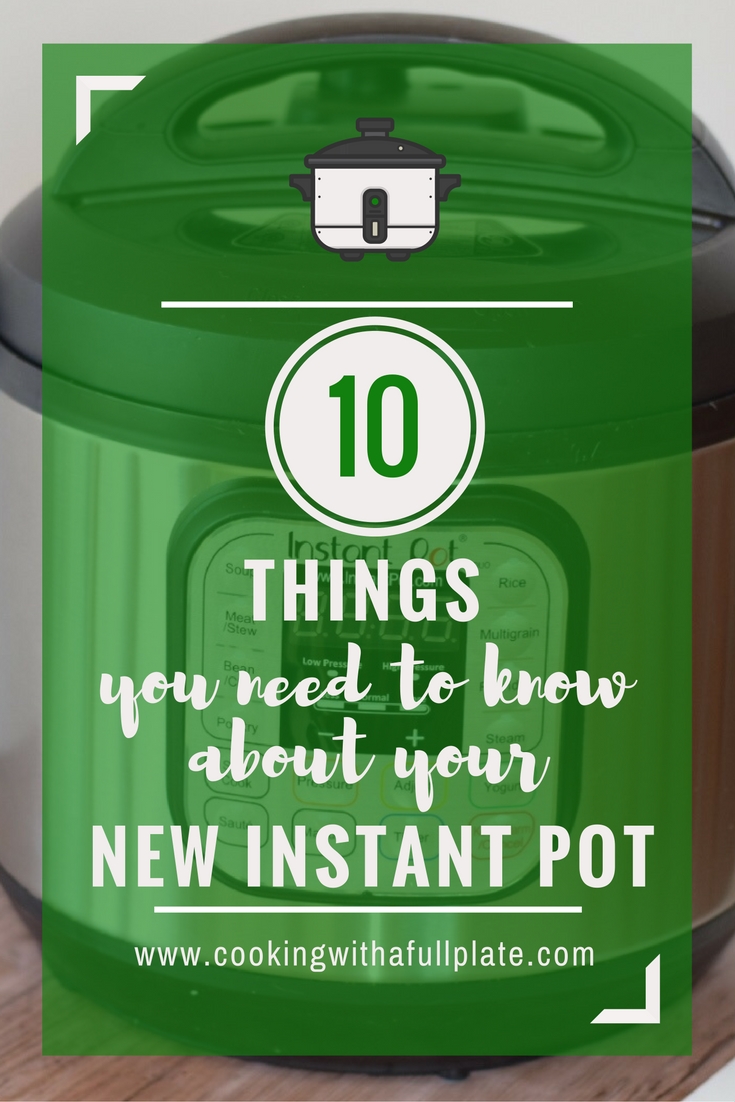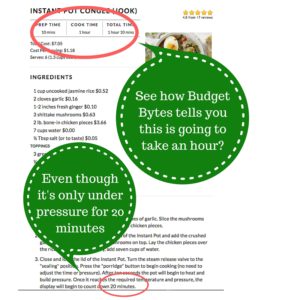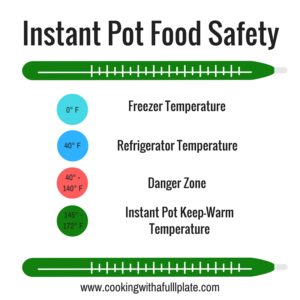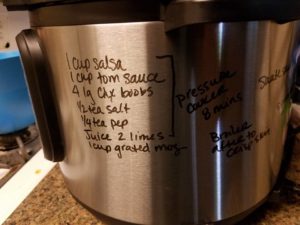Congratulations! I’m guessing you’re here because you recently made the decision to finally get one of those fancy pressure cooking machines that everyone’s been talking about.
Usually, this is the point at which I see lots of people say “I got my Instant Pot, but I’m too afraid to take it out of the box”.
No longer! We’re going to do this together. Let’s get started with 10 things to know about your new Instant Pot.
Or maybe you’re looking for something specific:
- Pressure cooking history
- Pressure cooking safety
- Getting started
- Recipes that work best with pressure cooking
- Instant Pot “keep warm” function
- Is the Instant Pot dishwasher safe?
- Yogurt in the Instant Pot
- Great Instant Pot recipes

1. Pressure cooking is an age-old tool.
While Instant Pots and other similar electric pressure cookers seem to be experiencing a moment in the limelight, the technique itself of using pressure to lower the boiling point of water is nothing new. In fact, according to Wikipedia, French physicist Dennis Papin, first invented the “steam digester” in 1679.

I have no idea where this photo originally came from, but I found it at ZeroHedge.com.
The main thing to understand is that by trapping the steam from the boiling water, you’re actually raising the temperature of the water from 212° F to 250° F, which naturally cooks the food faster.
Think about it this way – if you raise your oven temperature from 300° to 350° your casserole will heat up faster and need less time in the oven. Since you can’t raise the boiling point of water by just boiling it longer, you need the assistance of something else, in this case, pressure from captured steam, to make it hotter and work faster. (Source: On Food and Cooking by Harold McGee)
Note that because the Instant Pot operates at 11.6 PSI rather than 15 PSI, it is actually cooking the food at 242° F rather than the above stated 250°.
2. If you use it right, it won’t explode.
It doesn’t take much to find over 100,000 people who have shared their experiences (or videos) of pressure cookers exploding. When I first started using one (a stovetop version in a traveling cooking class) it was the biggest question that I got from both participants and the main thing I worried about myself.
Here are the reasons I don’t worry about that as much with my Instant Pot:
- There is an anti-blockage vent: a vent block is one of the main reasons pressure cookers explode
- Automatic pressure control: if you’ve used a stovetop pressure cooker in the past, you know the struggle of adjusting the stove heat to ensure the pressure stays at the right level. The beauty of the Instant Pot is that it does this for you automatically.
- It has lid detection: getting the lid on right seems to be one of the most important safety precautions of using a pressure cooker. The Instant Pot has both lid close and lid leak detection that will not allow the machine to come to pressure if it’s not functioning properly.
All in all, Instant Pot has 10 safety features to help ensure the stress-free operation of their appliances.
3. You’ll only need to follow those lengthy instructions a couple of times before you can do it yourself.
The most important thing you can do to safely operate your Instant Pot is to ensure you’re using it correctly. That means that no matter how much you hate reading directions, go through the manual step-by-step a few times as you start using your device.
I assure you that after a few recipes you’ll get the hang of the basics and won’t need the detailed guidance any longer.
4. It’s going to take a little longer to cook than the recipe implies.
When I first got my Instant Pot, I was surprised to find that my brown rice wasn’t magically ready in 25 minutes. Now that I understand the basic science of the contraption, I can see why this is the case. After all, the water has to both boil and create enough steam to raise the internal pressure in order to raise the heat of the water.
This process can take anywhere from a few minutes to quite a while (upwards of 10) depending on the temperature of the items in the Instant Pot and the volume of the food/liquid you’re cooking.
As mentioned several times in this article on About the Chef, “the countdown will only begin when working pressure has ben reached.” Likewise, the time to make a pressure cooker recipe often only reflects that time those ingredients are under pressure. You’ll need to learn to account for both the time it takes to bring the ingredients to pressure and the time it takes for pressure to release, which can take from 3-30 minutes depending on the method.
According to Hip Pressure Cooking’s Pressure Cooker Troubleshooter, a fantastic resource for the Instant Pot and more, “A pressure cooker with frozen ingredients will take 20 to 30 minutes to reach pressure”.
Speeding up the time it takes to come to pressure
In my very “scientific” study, I cooked 2 turnips in 1 cup of water two different times – once I started with room temperature tap water and the next was with boiling water.
You can see the difference below:
- Room temp water: 7:41
- Boiling water: 4:46
Both times, it also took about 5 minutes to naturally release the pressure. For reference: When cooking 2 cups of brown rice, it took closer to 12 minutes for the pressure to release.

This is why in the recipe above from Budget Bytes lists the cook time as 1 hour when it’s only under pressure for 20 minutes. That’s an honest recipe!
5. There are recipes that are better suited to pressure cooking than others.
While I’m sure it’d be possible to eat out of your Instant Pot alone (if I had to choose one appliance to cook with forevermore, I must admit that this might be the one), you may find at first that many of the foods you’re making in your pressure cooker are very similar. There are two reasons for this:
- Pressure cookers are really good at cooking things in liquid, which is why you’ll notice in fantastic recipe round-up posts like this one from Nom Nom Paleo and this one from Dad Cooks Dinner that there are a bunch of stews, braised and pulled meats, and beans – because they work really really well!
- You’re not branching out and trying out new techniques in your cooker. A pressure cooker is just like any other cooking appliance. If you pick the same things over and over again they’ll taste the same. In the wise words of Laura Pazzaglia of Hip Pressure Cooking “Change-up the cooking method and give boiling a break so your pressure cooker can reward you with boundless flavor”.So for goodness sake, try something new to give you taste buds, cooking skills, and Instant Pot a workout! Some ideas:
- Pressure cooker crispy potatoes uses steaming and then pan-frying
- This Amazing Caramelized Apple Crumb Cake utilizes a pressure cooker bain marie technique
- Try out Pressure Cooker Macaroni and Cheese from Eat at Home Cooks, which could seemingly be adapted quite easily to be gluten-free by choosing a gluten-free pasta, especially since you don’t have a pesky roux to deal with
- I can’t wait to taste this 5 Minute Pressure Cooker Shrimp Scampi Paella from Health Starts in the Kitchen
5. Slow cooking is one of the best ways to use the Instant Pot.
I know it’s not the most touted use for the Instant Pot, but it is one of the 6 or 7 things it can do and I find that it is one of the best “slow cookers” I’ve ever used. Let me take a moment to wax poetic on why:
- The inner pot is stainless steel rather than non-stick like many of the other slow cookers out there. I prefer this because of its versatility for browning and the minimization of toxic chemicals, especially since we avoid non-stick surfaces in the rest of our kitchen equipment.
- It has a saute function that allows you to actually brown ingredients in the pan itself rather than have to cook things in a separate pan and then transfer them to the slow cooker. This is super important if you 1. like flavor and 2. don’t like dishes.
I’ll often use slow cooking on something I’m starting in the morning and eating for dinner since I have the time to let it sit and cook slowly and gently all day. Plus hot dinner when you get home – it’s like having your own personal chef!
6. You can make dinner in the morning (or vice versa).
With either the pressure cooker or slow cooker functions the Instant Pot will hold at a “Keep Warm” temperature after cooking, so you can actually cook your food long before you’re ready to eat it and then just hold it at the automatic warm temperature for up to 10 hours. Or, you can set it on the manual “Keep Warm” setting for up to 99 hours and 50 minutes!
I wouldn’t necessarily recommend waiting that long, as I do think the food has a tendency to cook a bit more over time, but this has the advantage of letting you start dinner in the morning or breakfast at night and have it be warm and ready to go when you are. This, in my opinion, is the biggest selling points for parents who are rushing to or from work and need to feed kids, families that are juggling life and sports, or singles who want the convenience of having food ready when they are!
For those concerned about food safety, the keep warm temperature operates at 145 ~ 172°F according to Instant Pot’s site, which means it’s holding your food outside of the “danger zone” where bacteria is most likely to grow.

7. Many of the parts are dishwasher safe.
I know I said that the Instant Pot is the appliance I’d take with me to a dessert island, but the only reason that’s true is because I figure my dishwasher won’t be that useful there.
Officially, Instant Pot says that the inner pot, steam rack, and spoons are dishwasher safe. I’ve found this to be true and incredibly useful with multiple washings.
Unofficially, I’ve also found that the lid and gasket do fine (so far) in the top rack of the dishwasher and it does quite a good job of getting them clean despite the warnings that there are too many small parts and crevices.
Not feeling as lazy as I am? The Kitchn has created a very comprehensive step-by-step guide to cleaning your Instant Pot for the more meticulous owners.
8. You may, in fact, end up making your own yogurt.
There are weeks that I can barely remember to buy yogurt, so when I finally switched over to the 7 in 1 Instant Pot from my original 6 in 1 version, I was dubious that I’d ever make use of this illustrious extra function. What I found, though, is that it’s so easy and inexpensive and hands off, that if you are a heavy yogurt consumer it actually is worth it to make your own.
With the exception of pushing a few buttons, yogurt making is extremely hands off and the biggest thing you’ll have to make do is to empty space in your fridge and put the yogurt into jars for storage.

Don’t believe me? Check out some of these awesome recipes for Instant Pot yogurt:
- Don’t be fooled by all the steps here – they’re just showing you every. single. thing. you’ll need to do as part of the process. Team Yogurt gave a very thorough insight into Instant Pot yogurt making and whether it’s worth it. I find it hard to disagree with anyone who has a tagline as awesome as “not spoiled, just cultured” but as someone who doesn’t make yogurt the “traditional” way because it involves too many steps and babysitting, I think that the Instant Pot is the only way to make yogurt at home!
- This version from Shrinking Monster gives a really straightforward explanation of making Greek yogurt if that’s more your thing.
- Are you dairy-free and tired of paying $2 per serving for coconut yogurt that usually has sweetener? I’m planning to try this lovely version from The Primal Desire once I secure the grass-fed gelatin to thicken it.
9. You’re going to find more uses for it than you thought!
I must admit that I haven’t fully ventured into this space yet, but I love the idea of getting creative and using it in new ways. Here are a few I’m vowing to try:
- Hard boiled eggs
- Steamed sweet potatoes (or regular potatoes)
- Spaghetti squash
- Steaming frozen salmon filets (thanks Costco)
- Cheesecake!! – I’m deeming this salted caramel version from Cookies and Cups healthy because it’s good for the soul 😉
10. You’re going to make some mistakes – but don’t worry, you’ll eventually have a long list of successes!
One quick search for “fail” in the very prolific 90,000+ member Facebook group turns up pages upon pages of results. And hundreds of more responses of commiseration, suggestions of what to do differently next time, and other favorite recipes.
Here’s my confession: Despite owning two different Instant Pots for over 3 years, I made mushy brown rice this week. Through miscalculation and not enough reading, I added too much water. Luckily, it was just rice and since it was short-grain it will actually work well in some “sushi”, but all the same, it wasn’t what I was trying to make.
I remade another batch using the correct ratio and you can see the difference here:

So basically the Instant Pot is much like life. You’re going to fail, but if you surround yourself with the right guides (people, recipes, instructions), you’re bound to recover and be even more successful in the long run. And really, can you put a price on lessons like this? 😉
But seriously, find yourself a group of people who know what they’re doing. I recommend your 90K closest friends in the group above, but I’m sure there are others out there. If your Facebook Feed can handle it, being part of a group will help you to learn what works and what doesn’t, will notify you of great recipes, and above all will keep your Instant Pot top of mind. Plus, you can find cool ideas like this one:

My friend, Sarah, a new IP user shared this awesome idea to write your recipe on the side of the Instant Pot in dry-erase marker.
___________________________________________________________
Happy cooking! Now get out there and try something new with your Instant Pot 😀
This post contains affiliate links. As an Amazon Associate I earn from qualifying purchases.